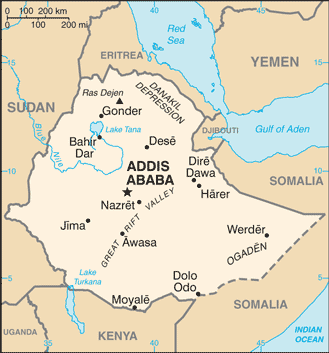Ethiopia

The Federal Democratic Republic of Ethiopia has an estimated population of 84.9 million (UN, 2010). The capital is Addis Ababa. Ethiopia has an area of 1.13 million sq km (437,794 sq miles). The main languages are Amharic, Oromo, Tigrinya, and Somali.
Ethiopia is considered to be Africa’s oldest country. Apart from a brief occupation by Italy under Fascist leader Benito Mussolini from 1936-1941, Ethiopia is unique among African countries because it has never been colonized. Wide-scale drought, famine, war and massive refugee problems plagued the country in the 1970s and 1980s. After the independence of Eritrea in 1993, bad border demarcation led to a war between Eritrea and Ethiopia, which was ended in 2000 with a peace treaty.
In 1995, the constitution of Ethiopia adopted equal rights for men and women in every sphere of life. Despite the government efforts for gender equality, little attention is being given to promoting women's participation within the community. Men dominate political, decision-making and leadership positions. Women have limited access to education.
- Ethiopia signed the Protocol to the African Charter on Human and Peoples' Rights on the Rights of Women in Africa (The Maputo Protocol) on the 1st of June 2004.
- The Convention on the Elimination of All Forms of Discrimination against Women (CEDAW) was ratified by Ethiopia on the 10th of September 1981.
- Ethiopia has not yet adopted a National Action Plan on United Nations Security Council Resolution 1325 (UNSCR 1325).
- From 31 July 2000 to 31 July 2008, there was a UN peacekeeping mandate in Ethiopia: United Nations Mission in Ethiopia and Eritrea (UNMEE).
Source: BBC, AlertNet, CIA, UN, SIGI,
